SCENE
ARTS AND CULTURE MAGAZINE
MURALS GALORE
Public art bloomed this spring with four new murals on City College campus
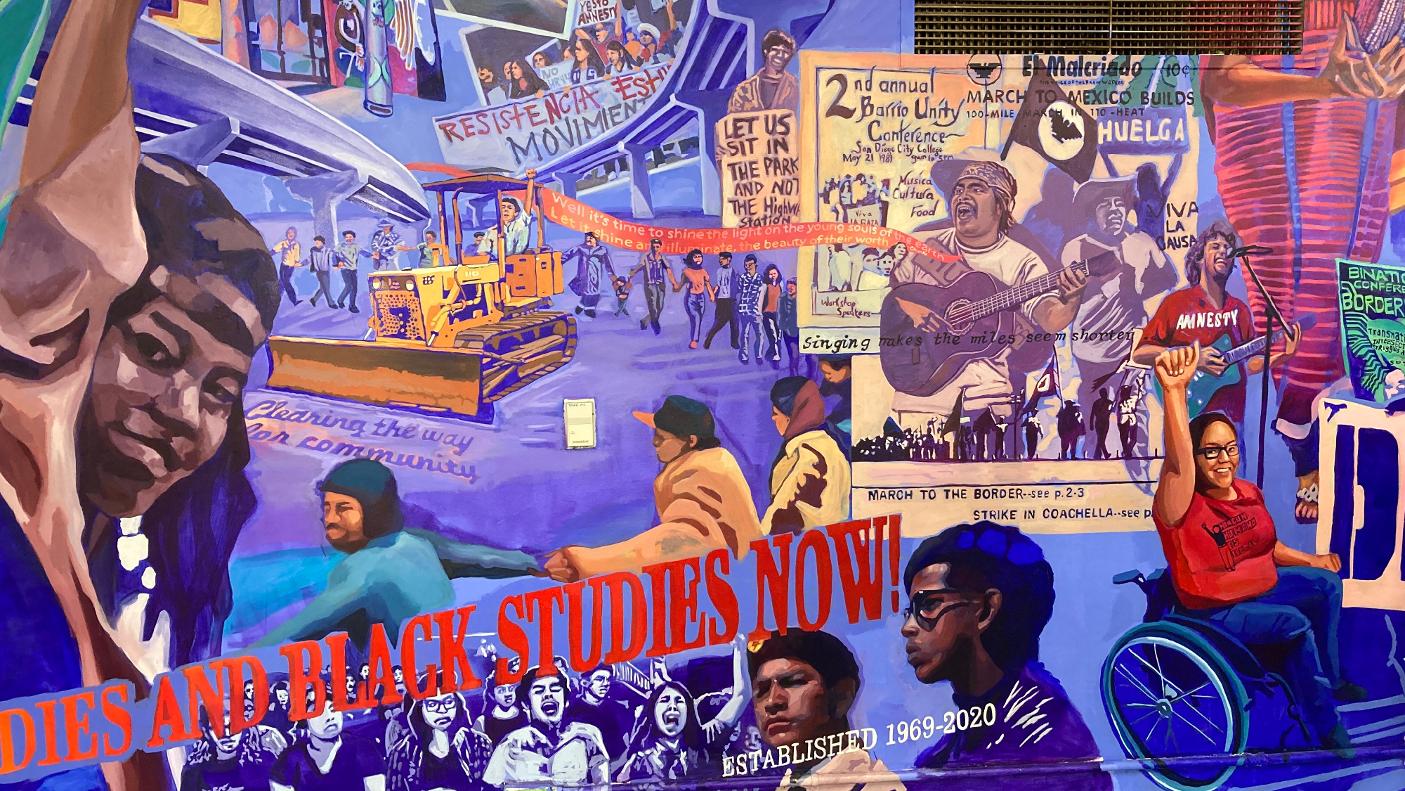
OPEN
ARTAS ANTIDOTE
How City College is using art to raise mental health awareness
CELEBRATINGIDENTITY
San Diego City College's Lavender Graduation ceremony part of a weighty tradition
CITYSCENE
CONTACTINFORMATION:

City Times Media San Diego City College 1313 Park Blvd. | San Diego, CA 92101 Newsroom: L-117

Staff
Kathryn Gray, Editor-in-Chief
Jakob McWhinney, Managing Editor
Kathy Archibald, Enterprise Editor
Philip Salata, News Editor
Susanna Serrano, Multimedia Editor
Antonio Contreras, Sports Editor

Advisers
Nicole Vargas, M.A. Peggy Peattie, Ph.D.
MURALSGALORE
Front and back cover: "50 Years of Chicana/o Studies" mural by artist Alicia Maria Siu Photo by Kathy Archibald/City Times Media


DISTRICT POLICY STATEMENT:
This publication is produced as a learning experience under San Diego City College's Digital Journalism program. All materials, including opinions expressed herein, are the sole responsibility of the students and should not be interpreted to be those of the college district, its officers or employees






Murals Galore
Public art bloomed this spring with four new murals on City College campus

flourish of public art bloomed across the City College campus during the zero-to-fully-open spring 2022 semester. Here?s a rundown of art made by and for various City communities
?Honoring Our Ancest ors?
Amidst the buzzing lights and echoing voices of the AH Building parking garage, a colorful merging of past and present greets drivers heading to class
Terri Hughes-Oelrich, a fine art professor at City, was inspired to help transform these drab concrete walls She reached out to Kumeyaay artist and former City student Kenneth Banks to design the first piece ??Honoring Our Ancestors ?
The mural blends Kumeyaay figures with two references deeply personal to Banks
A large form reminiscent of a centipede adorns the left side of the new mural ?a figure Banks describes as his ?healing symbol ?
Backpacking through Indonesia years ago, an encounter with hallucinogenic mushrooms left him suffering from an allergic reaction, then severe sunburn and dehydration after falling asleep on a beach Banks lost 40 pounds lying in bed for a week, only then gathering the strength to reach a hospital.
He said that centipede-like figure provided comfort and an impetus to literally crawl for help during those dark days.
The large red form to its right was inspired by one near Death Valley that reminded him of a kachina ?
a concept in the Pueblo Hopi culture Banks likens to angels.
The remainder of the mural is composed of designs documented in San Diego County and Northern Baja California ?the land of the Kumeyaay tribe. ?I have art here I can work with from our specific ancestors,?he said
Banks grew up in Ramona, a member of the Iipay Nation of Santa Ysabel where his grandmother explained the health benefits of creating art and taught him the meditative process to produce what she called ?dream windows ?
Trained in architecture, Banks found his way to a career in art ? directing the American Indian

class at City with Hughes-Oelrich He kept enrolling over the next few years and ?got alive again ?
Adecade later, she asked him to design the mural
Students and volunteers helped Hughes-Oelrich paint, referencing Banks?design projected onto the garage wall, honoring Kumeyaay of the past and today.
?50 Years of Chicana/ o St udies?
City?s cafeteria is now home to a mural celebrating the 50th anniversary of the Chicana/o Studies department.
Faculty refocused resources from the canceled 2020 Chicano-Latina graduation ceremony on a mural, said Norell Martinez, an associate professor of English and Chicana/o studies at City
After his mother, uncle and grandmother all died within an 18-month time span, Banks returned home from Northern California to heal
Eventually looking to reinvigorate his joy in art, Banks took an art
Martinezsaid the resulting committee selected muralist Alicia Maria Siu, who was raised in Honduras and follows the collective mural-making process she learned from Malaquias Montoya at UCDavis
?It?s not coming from the artist, what we want to see,?Siu said ?It?s exactly what the community wants ?
Martinezexplained that while the mural was championed by the
Contemporary Arts gallery in San Francisco in the 1980s, and eventually selling his own work, including pieces inspired by his grandmother."I have ar t her e I can wor k with fr om our specific ancestor s.?
Chicana/o Studies department, the group wanted to include the broader context of student activism
?If we fight for our rights,? Martinez said, ?then we also want to fight for the rights of our African American brothers and sisters and our other communities as well ?LGBTQ folks, women, et cetera.?
Within the mural, Siu detailed multiple causes, protests, quotes, sit-ins, stories and inspirations, largely based on photographs and descriptions of real events in City?s history of activism

The left side of the mural depicts City student Mario Solis and others who interrupted a bulldozer, making way for Chicano Park.
Students also wanted to highlight Black Lives Matter, police brutality and the Kumeyaay ?Landback?movement ?families impacted by militarization and border divisions, Siu said
While gathering reference photos to represent a Kumeyaay woman, Siu found an unidentified photo, which the group decided to use.
After posting a photo of the
mural in progress on her Instagram page, someone identified the woman, putting Siu in touch with Toni Marie Dominguez and solving the mystery
Siu apologized for the shock of her likeness in the mural, but Dominguez told Siu she found it an accurate reflection of her own family?s struggle navigating

border separation imposed upon her homeland Referencing the mural, Domingueztold Siu, ?I think it worked out perfectly and I?m all for it,?Siu said.
The mural was officially unveiled in May. The event included a drum blessing from Red Warrior drum group, opening the area to the campus community
Siu said she hopes the space helps empower students
?It really matters what you see around you,?Siu said ?If you change the space, it can empower you to know that you belong.?
Social Just ice mural
Spearheaded by the Sankofa committee, which organizes the
annual Social Justice and Education Conference, a geometric art piece now adorns the west ramp of the AH Building.
3B Collective, a Los Angeles-based group of artists and designers, was chosen to create the work.

Oscar Magallanes, who helped found the group with fellow UCLA undergraduates, said 3B Collective functions as a creative community and peer support group for Chicano, Latino and Indigenous artists.
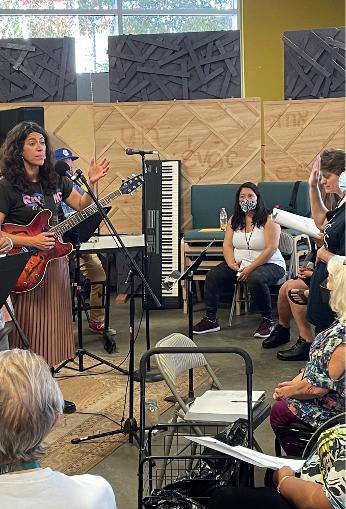
Through collaboration with City students, Magallanes said the group developed a design referencing modernism in architecture and the cement face of the community building, Mayan traditions and modern Mexican and Indigenous voices, water protectors, and a tree of life or axis mundi, among other iconography
Magallanes said the mural, created using adhesive stencils, incorporates the Mayan phrase ?In Lak?ech Ala K?in,?meaning ?You are my other me What I do unto you, I do onto myself.?
Birds and more
Joining the Kumeyaay mural, portraits of birds now greet drivers in the AH Building garage Hughes-Oelrich said the bird species were chosen in conjunction with the City College Audubon Club


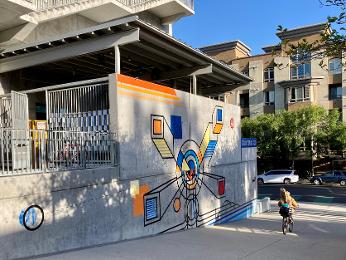
Also planned for the area will be a collaged work based on written word submissions from students, and a piece from a local artist addressing bipolar disorder, Hughes-Oelrich said.

Follow @sdcityart on Instagram for opportunities to get involved with murals on campus, and follow City Times Media at @sdcitytimes on Instagram to stay up to date on campus news!

"If you change the space, it can empower you to know that you belong.?
Alicia Maria Siu, CommunityMuralist
CelebratingIdentity
SanDiego CityCollege'sLavenderGraduationceremonypart of a weightytradition
ByJakob McWhinney, ManagingEditorOn a sunny mid-May afternoon, San Diego City College held a Lavender Graduation ceremony on the campus?Curran Plaza.
It was a joyous event by all accounts, with students, family members and faculty gathering to celebrate the achievements of the college?s LGBTQIA+ graduates
Lavender Graduation's are something of a complement to
traditional commencement ceremonies and aim to give LGBTQIA+ students a place to both recognize and celebrate their identities

The event was small as far as commencement ceremonies go, with only around thirty attendees
This was largely a function of the word-of-mouth nature of the promotion surrounding it and the difficulty identifying students in this demographic
?It was a really personal event,? said Rocky Dove, a 20-year-old
City graduate working to transfer to UCSan Diego to pursue a degree in cognitive science.
?I'm really glad that we were able to make that space for people,?he said.
As far as anyone involved in the planning of the event can tell, it was the first in City?s 108-year history But that?s not a huge surprise
The tradition only dates back to 1995 when Ronni Sanlo, then the director of the University of Michigan?s Office of LGBTAffairs
created the inaugural event.
Ashley Burch, program support technician in the EOPSNextUp office, said she hoped it would be a way to give LGBTQIA+ students a fuller sense of belonging NextUp EOPSpresented the event alongside the City program ¡SUBIR!
?We wanted to have our first annual Lavender Graduation to honor our LGBTQ+ students and to acknowledge their achievements and contributions while they were at City,?Burch said

Despite the celebratory nature of the events, both the choice to name them ?Lavender?Graduations, and Sanlo?s impetus to create them were born from experiences of bigotry.
The color has long played an important, though often prejudicial role in the LGBTQIA+ community. Its first connection to queer culture comes from the 7th-century Greek poet Sappho, who described in her poems the ?violet tiaras?worn by her female lovers Sappho?s work was so influential that the phrase lesbian is derived from Lesbos, the name of the isle on which she worked.
But as history progressed, the hue of purple altered slightly.
A biographer of President Abraham Lincoln described his friendship with a man with whom he shared a bed as having ?streaks of lavender ? And during the McCarthy era of American history, ?The Lavender Scare?led to thousands of Americans being fired from their government jobs solely due to their sexuality
Like many groups faced with unjust discrimination and overt oppression, the term has largely been reclaimed and now represents pride, albeit pride heavy with history.
Program support in City's EOPSNext Up office speaks to a City student at the Lavender Graduation City College Flickr
?We wanted to have our fir st annual Lavender Gr aduation to honor our LGBTQ+ students and to acknowledge their achievements and contr ibutions while they wer e at City.?Ashley Burch, Program support technician in the EOPSNextUp office
For Sanlo however, the inspiration for the name comes from an even darker period She?s said it combines the black and pink triangles lesbian and gay prisoners, respectively, were forced to wear in Nazi concentration camps.
Sanlo, a lesbian woman, said she was inspired to create Lav Grads, as the ceremonies are often referred to, when she was denied the opportunity to attend the graduation of her biological children because of her sexuality
Through that experience, she came to more fully understand the pain felt by many LGBTQIA+ students ?who spent most of their college years succumbing to invisibility on their campuses,? Sanlo wrote in a piece for Campus Pride.
She also saw the need for a way to recognize and honor those experiences.
In the nearly three decades since that inaugural University of Michigan event, it?s become a tradition at colleges across the country, from Vermont to Washington to Louisiana And now, it's come to City College
'No group is monolit hic'
Unlike most collegiate Lavender Graduation ceremonies, which are usually put on by campus LGBTQIA+ clubs or organizations, City?s event is presented through a partnership between Next UP? a program created to support current and former foster youth ? and ¡SUBIR!
¡SUBIR!, an acronym for Students Uplifted by Institutional Reform, is a program funded through a pair of federal Title VDepartment of Education grants awarded to City for its role as a Hispanic-serving institution It began primarily as a resource center for undocumented students.
But Adan Sanchez, City?s acting dean of student services, said it?s since expanded to include a variety of resource centers for different student populations
From hubs for womyn, first-generation students, and veterans, they?ve all been centralized under ¡SUBIR!, with funding coming from the grants
City College president Ricky
One of those additions is the Pride Hub, which was created during the COVID-19 pandemic. Sanchez said it?s a place for LGBTQIA+ students to socialize, receive services and support students proactively rather than in reaction to challenges. City?s Lav Grad was conceived as part of push to develop the hub Sanchez said because data shows LGBTQIA+ students experience significantly more challenges along their educational journey, including lower retention and graduation rates, recognizing their experiences could be helpful.
Studies have also shown if those barriers were removed, and students received more support from campuses, those disparities would be significantly diminished
primary language, the needs of each group vary, but they also overlap and intersect
?I wanted to make sure that when we were building these spaces, we focus in on the intersectionality of these identities,?Sanchez said. ?Because not one sort of experience is the same ?
?We?re not going t o st and For less?
The other big reason the Lav Grad isn? t powered by a student-run LGBTQIA+ club is because there no longer is one
"It could be r ap, it could be a countr y song, it could be a poem. Whatever the case may be, as long as it comes fr om your hear t and what you have exper ienced in your r eality it?s beautiful.?

Prior to the pandemic, City had the Family Club, whose stated goal was to engage City students in the fight for LGBTQIA+ equality, through activism, education, and advocacy.
"
Part of the reason for the diversification of offerings, Sanchez said, is because of the inherent diversity of the Latinx community.
?No group is monolithic,?he said From differences in socioeconomic status, gender, sexuality, parental status, employment status and
Dove, a peer mentor in the ¡SUBIR! Intercultural Center said he was involved in the club prior to the pandemic, but distance learning made organizing nearly impossible
Christopher Edmonds, Voicesof Our CityChoir memberBut Dove questioned if this centralized method of delivering resources to the community is the most effective one, saying in his
opinion it wasn? t working all that well
?We can have all of the signs and webpages and stuff, but unless students have real resources they can connect with, I don't think the campus is doing enough,?he said Sylvia Ramirez, City?s current Title Vprogram activity manager said because Title Vfunding is ending, changes will inevitably come to the Pride Hub. One of which, she hopes, will be a more independent Pride Hub
?I also believe it should be a standalone office that has the appropriate counselors, the appropriate connections and support for our students,? Ramirez said.
She said because Title Vfunding requires activities to be primarily focused on ensuring student academic success there?s a need to complement the hub?s current programming with more community engagement activities.
As the funding ends, and the Pride Hub?s cost is absorbed by
City?s general budget, it will have more freedom to pursue a wider range of programming
But despite the challenges, Ramirezhas been encouraged by
what she sees as a renewed commitment by faculty to support LGBTQIA+ students Especially as a wave of anti-LGBTQIA+ initiatives has swept the nation.


?We're not going to stand for less,?Ramirez said. ?On this campus right now a lot of like-minded people are getting together so that we can see change happen while we're here,? she continued
?And I think it's a great thing ?
?We can have all of the signs and webpages and stuff, but unless students have r eal r esour ces they can connect with, I don't think the campus is doing enough,?
Rose Dove, CityCollegestudentAn attendee of City's Lavender Graduation poses in her rainbow colored VANSsneakers. City College Flickr Sylvia Ramirez, City's Title Vprogram activity manager, greets a student at a 2019 Friends of Downtown scholarship event City College Flickr
MakingSweetMusic
SanDiego CityCollege alum bringing home with music
Edited bySusana Serrano, Multimedia EditorTThe House of Music is a non-profit organization that provides free Latin music lessons to underserved youth in San Diego County.
City College alum Chris Springer started the organization when he
noticed the lack of music programs for students in San Diego's South and East County communities.
Instructors of the organization taught children at the East County Living Transition Center, a temporary home for families facing housing insecurity, every weekend in preparation for the charity
concert Cuba Llego at The Rady Shell at Jacobs Park
On May 1, the children performed at The Rady Shell at Jacobs Park along with Los Van Van and Havana D?Primera. The House of Music will use concert proceeds to provide free classes, purchase new instruments and pay instructors

Children at the East County Transitional Living Center practice for the charity concert Cuba Llego.
Children at the East County Transitional Living Center learn about rhythm from music instructor Silvio Diaz-Fernandez.




TotheBeatof aDrum
Photo by Susana Serrano/City Times Media Photo by Susana Serrano/City Times Media Instructor Silvio Diaz-Fernandez from The House of Music teaches a student from the East County Transitional Living Center how to play the conga drum Photo by Victor OrtizJr /City Times Media Bottom: Children play the conga drums at the East County Transitional Living Center in preparation for the Cuba Llego concert. Photo by Victor Ortiz Jr./City Times MediaChildren
Children
Children


Students


Artas Antidote
HowCityCollegeisusing art to raisemental health awareness
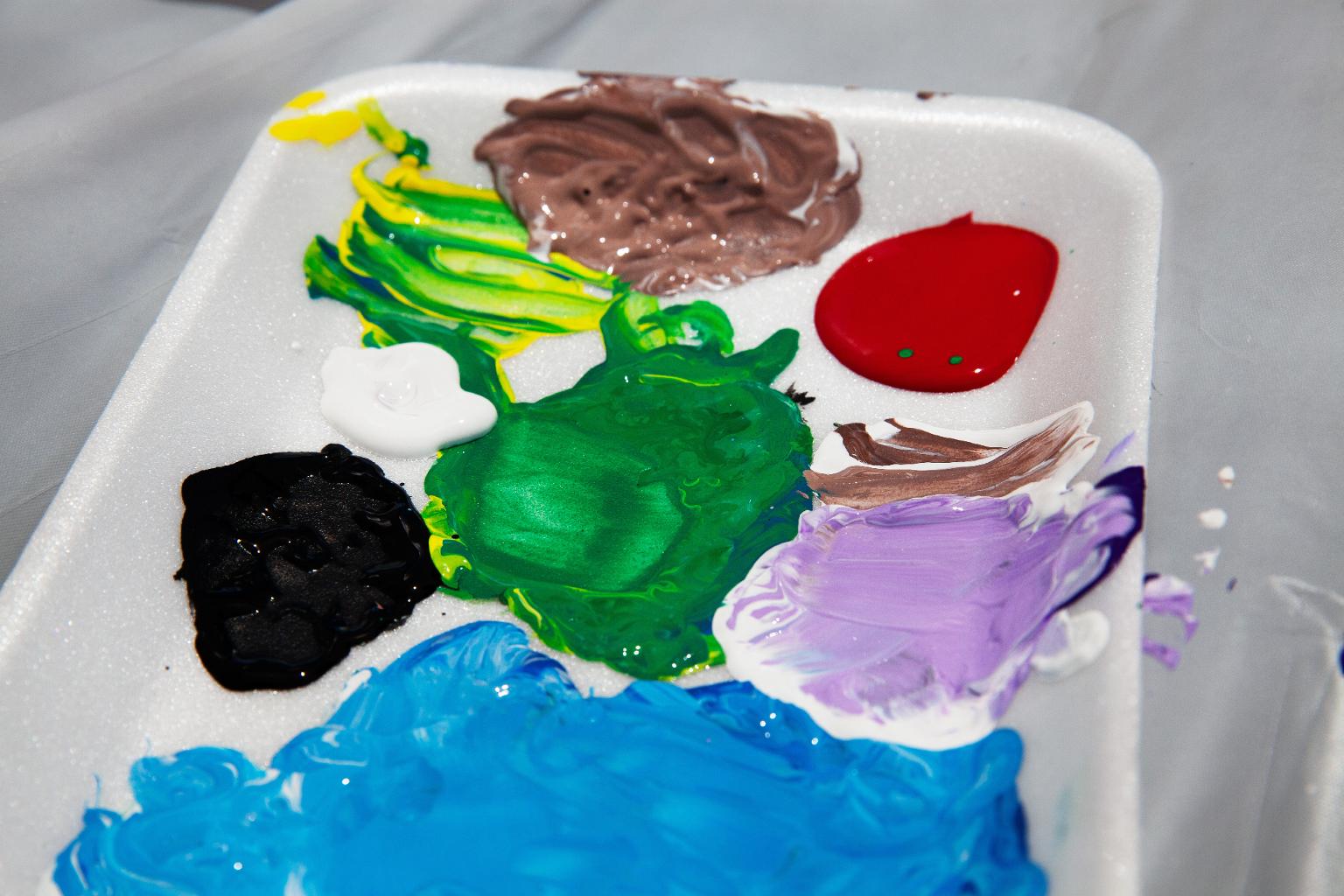
s an exercise for her research methods in psychology class, Ana Isabel Serrano made-up a fictitious survey with imagined results Her thesis was to show how student health center services impact the community college population
She started with the belief that mental health services are vital to students?well-being and then created the evidence.
That may seem upside-down, but Serrano had her reasons.
Detailed statistics about mental health can be tricky to gather because of privacy, and the topic has been historically taboo
As City College?s president of Active Minds, a student-run chapter of the nationwide mental health advocacy organization, Serrano has hands-on experience
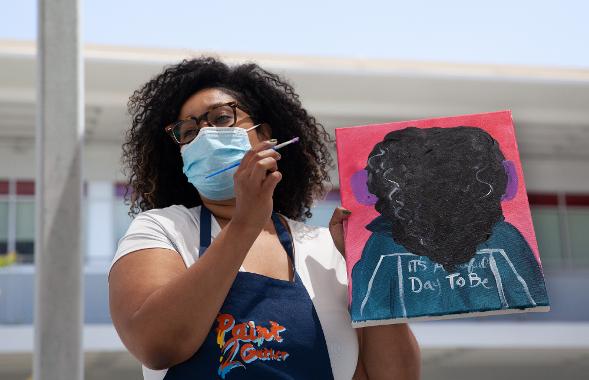
relating to students grappling with the complexities of mental health.
With the difficulty of gathering actual data, Serrano?s survey can be seen as a parable for the less definable impact of community-based interventions and how they can help students in need of support
?Data gaps can sometimes tell you more about what?s needed than actual data,?Serrano said
It also speaks to the challenges City administrators face in connecting students with those critical services, and how more creative forms of outreach may help increase awareness about those resources.

Serrano?s sentiment reveals the positivity she funnels into her work as a peer mentor, especially in confronting stigma surrounding mental health that can cause people to be reluctant to share their experiences
According to the American Psychological Association, respecting people?s privacy can be a delicate factor to navigate when trying to provide aid

City has numerous entities that strive to support students?well-being, starting with the Student Health Center and its mental health department, along with Active Minds But this broader support system overlaps with the many programs that focus on establishing smaller,
supportive communities. UMOJA, ¡SUBIR! and Puente Project, for example, support Black, Latinx, and students who may face challenges in completing a college degree

?This community college serves so many already marginalized communities, and it's so key to retain them and to support them and empower them,?Serrano said. ?And it shouldn't be only on teachers, it should be a whole infrastructure that?s attempting to do that ?
And in the case of mental health resources, Serrano added, ?it can change your life, right?
Communicat ion, communit y, art as ant idot e
Nested on the terrace above the cafeteria at City with the San Diego skyline as a backdrop, 35 students layered canvases with paint and focus.
R&B music played from a speaker situated in the middle of the group
 Joemar Martinez touches up his backdrop Photo by Philip Salata/City Times Media
City students take part in the communal painting session
Joemar Martinez touches up his backdrop Photo by Philip Salata/City Times Media
City students take part in the communal painting session
Artist Seranie Ruiz?s disarming voice wove into the soundscape as she guided the students in a communal painting session
Student Health Services contracted Ruizto lead the event as a part of a new approach to student outreach.
Mental health counselor Nadine Henley, one of the event organizers, said using art as a medium for students to engage with mental health services was an innovative approach to share information about campus resources
?It?s so calming to be able to focus on the next line and the next stroke,?Henley said ?We have a couple of our peer mentors sprinkled in amongst here Staff needs to engage in it too when we want to practice what we preach ?
Henley and her team received HEERFfunding, money allocated to programs for students affected by COVID-19, in order to carry out the event. They brought Ruiz? who studied human development and wanted to be a social worker ? from Long Beach because her services were a good fit
?Art came for me at a time when I didn? t know I had any talents and I was kind of depressed,?Ruiz said.
But when she learned she was good both at painting and teaching others, she said, it changed her life. Her services bridge arts with community making, something that seemed to resonate with her engaged audience at City.

With UMOJA also involved in the event, Ruiz worked with the theme, ?It's a beautiful day to be Black.?
Among the group was City student Linda Hersey. After 31 years working for the government
she decided to head back to school to foster two passions she had long put off ?mental health and child development.
Hersey said it was the perfect day to be outside and painting with
And for those who were enrolled in classes that are yet to have in-person instruction, it was an opportunity to meet their fellow students.
Isolation brought on by COVID-19 not only caused the majority of social opportunities on campus to dwindle, but also put pressure on the students?well-being
Sara Hubbard, a Black studies and liberal arts student, said the pandemic was something people have to learn to overcome. Even if there is a historical precedent, she said for people today, it's all new
others, taking her mind off other things she was thinking about.
?Yesterday was Mother?s Day and I miss my mom,?Hersey said.
Her mom passed away in 2016 and Hersey hasn? t celebrated the holiday since.
Scheduled just before finals, the event was also meant to provide students with some respite, inviting them to focus on color and form and take a break from the rush of the academic year
Samantha Jones, also a Black studies major, added the communal painting event showed City was thinking about its students?well-being at critical times.
?Art speaks to those parts of you where words just can? t penetrate, and at a depth of reality that is so grounded,?Jones said.
Act ive Minds plays it s role
Among the easels there were also student leaders like Serrano from Active Minds. As a peer mentor, being present and available is a part of her practice
"Ar t speaks to those par ts of you wher e wor ds just can? t penetr ate..."
Samantha Jones, CityCollegestudent

Serrano said many studies have found peer programs help students engage in mental health counseling services.
?The peer component is key because we are students,?she said, ?and we?ve been through similar things.?
Reflecting on the event the following day, Serrano and her team said they have also been brainstorming about community building events focused on art

She took on her role as president during the pandemic, and part of her work has been to help students transition back to in-person campus life
?How can we make it so that coming back to campus, people see each other and recognize each other, and come together??Serrano said ?Art was our conclusion
?It can be as in-depth or as superficial as you want,?she continued. ?I don? t think it's intimidating.?
And according to Verkouteren, it is through building community and trust that conversation about mental health can be destigmatized Cultivating a community of people he could relate to helped Verkouteren come to this realization And according to him, art can be a means of connecting with others.
?It took me many years to realize that opening up about mental health doesn? t make me a weaker person,?
Verkouteren said ?It's ok to ask for help and not feel like I need to work on this myself and only myself.?
Evelin Sanchez adds a dash of red to her canvasComeback
BY ANTONI O CONTRERAS Multimedia JournalistIt's been a tough road for San Diego City College students, especially students athletes, since the start of the COVID-19 pandemic Usually every fall of spring semester begins with basketball, tennis and volleyball matches.


But everything didn't play out the way it was supposed to go. City College athletes either had their seasons cut short or canceled for the whole semester. There was so much doubt if there was even going to be a season for each sports program
That ha just been the reality for all the students at City College for the last two years Athletes and coaches had struggles, even debating if they wanted to come back It's been frustrating for everyone just sitting down on the couch doing nothing, being trapped in a cage wanting to leave
We don't think it's a stretch to say the whole pandemic experience can make you want to keep pushing forward or just want to stop in general For the most part some didn't let the situation stop them but fueled them with more motivation of wanting to be back.
One of the challenges students athletes are facing is if they feel ready to be on the court with the pandemic still ongoing.
You can even say it was a short timeout that lasted longer than one would have hoped. Now with school sports making their way back, the feeling of wanting to go through the grind and grit of competing is a great feeling that sports programs have missed for so long
Carlos Robles
?I wasn't able to play but I was able to focus on myself and clean up some of the areas that I needed help in,?Robles said. ?I needed help in my conditioning, eating healthier and working on my diet during ? Phot o by Ant onio Cont reras
'
I was contemplating whether I wanted to keep doing this again, as much as it hurt to lose a season it really lit a fire in me, " Lupian said " it was a hiatus or rejuvenation of wanting to be here (City) and wanting to go through the grind and stress gave me the energy of wanting to be back." Phot o by Knight s At hlet ics
"Some girls didn't know if they wanted to play or not and it was a challenge for me to build a team and build a roster, " Dent said "I was able to do it because we kind of work together and some girls got back on board, and it was was great and everyone seemed excited " Phot o by Kat hy
Alyssa Fletes
"I love being able to come back to play after COVID. It was ha"rd coming back because I was just sitting on the couch all day," Alyssa said "I honestly didn't know what to do because I didn't know if I could continue training or putting in the work But I'm happy playing along side my sister and it got me excited to be back " Phot o by knight s At hlet ics




?During the lockdown, there weren? t many gyms open but I was fortunate enough to have one close to me and working every day in the pandemic, then over time The work is going to pay off ?Phot o by Knight s At hlet ics

Kally Novell
"So the fact that we have a solid group of 10 girls right now is honestly more than I could have asked for " Phot o by Kat hy
Jonathan Ogugua Audra Dent
